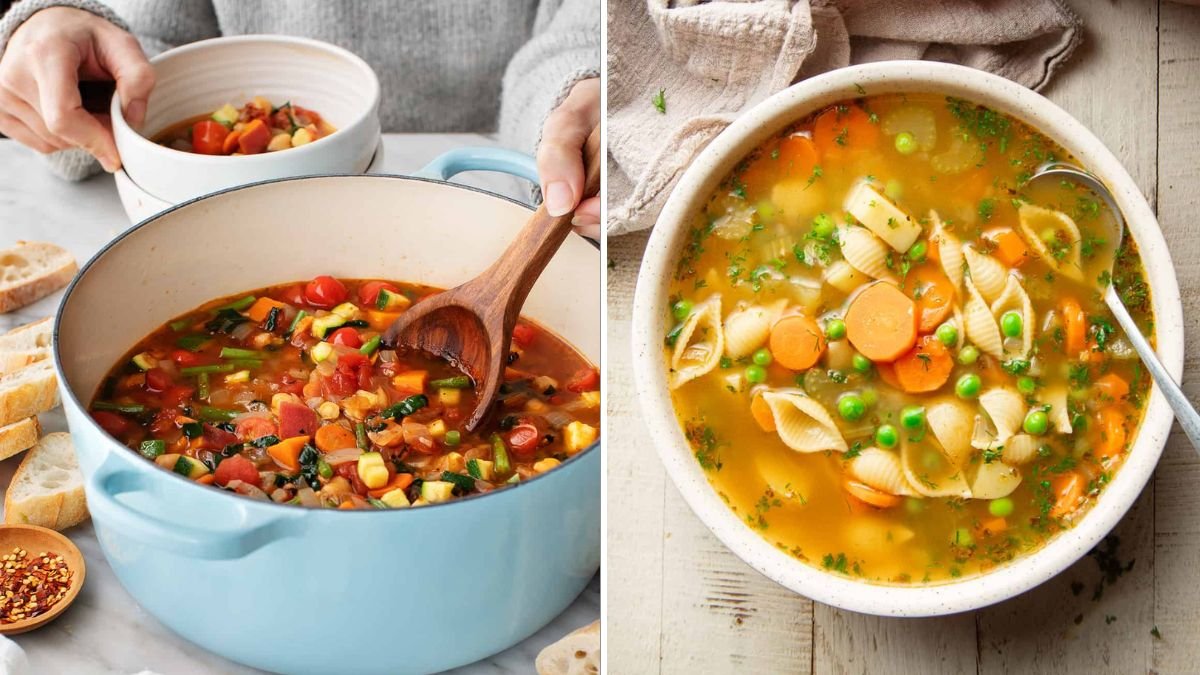There’s nothing more comforting on a chilly evening than a warm bowl of vegetable soup. Packed with fresh vegetables, herbs, and nutrients, this soup is not only hearty and satisfying, but also healthy and easy to make at home. Perfect for busy American households, this recipe is adaptable, allowing you to include your favorite vegetables while keeping the dish light, flavorful, and nutritious.
In this guide, we’ll walk you through 6 simple steps to make vegetable soup, ensuring a delicious, comforting, and healthy meal that will warm your soul on any cold evening.
Why Vegetable Soup is Perfect for Cold Evenings
- Warm and Comforting: Perfect for chilly weather or cozy nights at home.
- Healthy and Low-Calorie: Packed with vegetables and herbs, ideal for weight-conscious diets.
- High in Nutrients: Vitamins, fiber, and antioxidants support immune health.
- Quick and Easy: Ready in 30–40 minutes using fresh or frozen vegetables.
- Versatile: Serve as a starter, main dish, or with bread for a hearty meal.
Vegetable soup is not just warming and soothing—it’s also a nutritious option for Americans seeking wholesome, home-cooked meals.
Step 1: Gather Your Ingredients
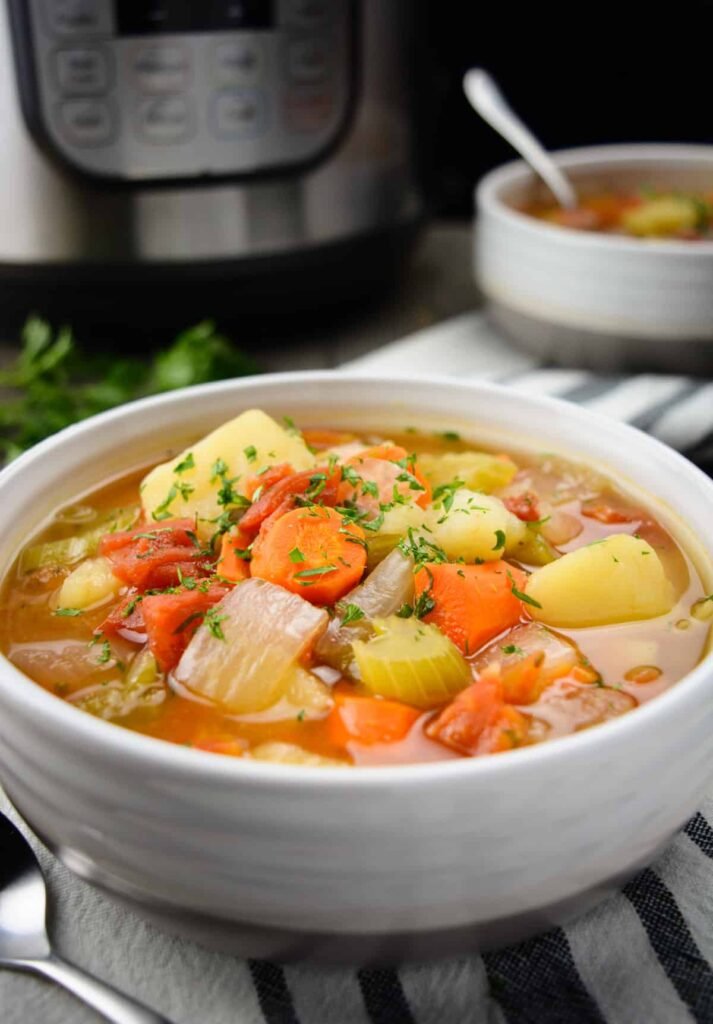
Using fresh, high-quality ingredients is the key to a flavorful and aromatic vegetable soup.
Vegetables:
- 2 medium carrots, diced
- 2 celery stalks, diced
- 1 medium onion, chopped
- 1 cup broccoli florets
- 1 cup green beans, chopped
- 1 medium potato, diced
- 1 cup corn kernels (fresh or frozen)
- 1 cup peas (fresh or frozen)
- 2 cloves garlic, minced
- 1–2 tomatoes, chopped (optional)
Liquids and Seasonings:
- 6 cups vegetable broth or water
- 1–2 tablespoons olive oil or butter
- 1 teaspoon dried thyme or Italian herbs
- 1 teaspoon black pepper
- 1 teaspoon salt (adjust to taste)
- ½ teaspoon paprika or chili flakes (optional, for warmth)
Garnishes:
- Fresh parsley or cilantro, chopped
- Lemon juice or a drizzle of olive oil (optional)
- Croutons or whole-grain bread for serving
Pro Tip: Use a mix of seasonal vegetables for maximum flavor and nutrition. Frozen vegetables work well for convenience and consistency.
Step 2: Prep Your Vegetables
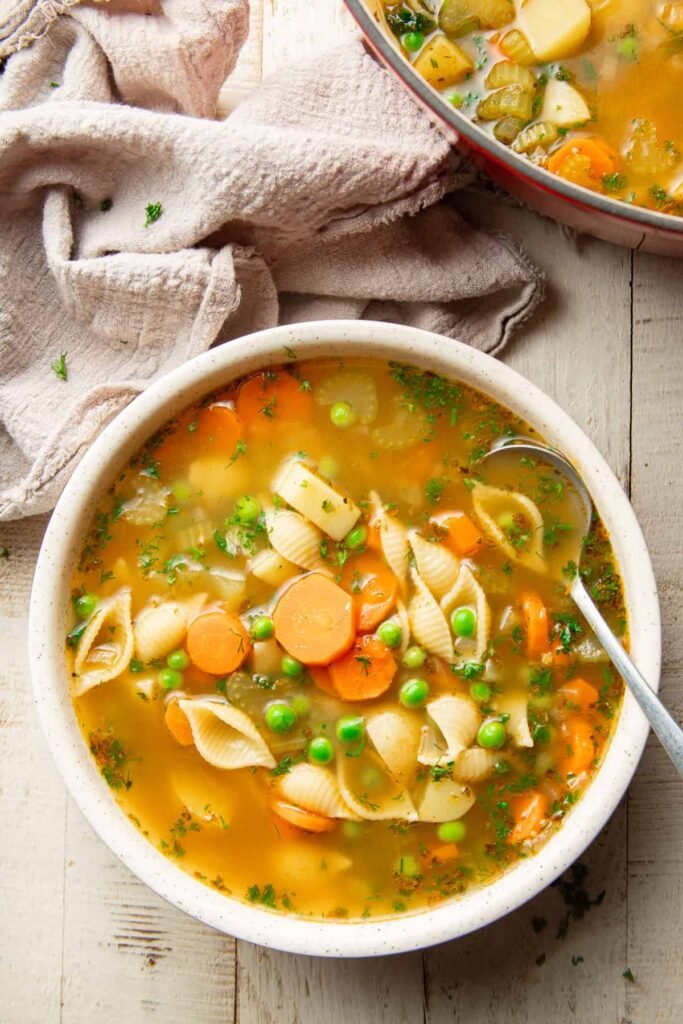
Properly preparing your vegetables ensures even cooking and optimal flavor:
- Wash all vegetables thoroughly.
- Dice carrots, celery, onion, and potato into uniform pieces.
- Separate broccoli into small florets and trim green beans.
- Mince garlic and chop tomatoes if using.
- Keep all ingredients ready before starting, as sautéing and simmering happen quickly.
Pro Tip: Smaller pieces cook faster and release more flavor into the broth.
Step 3: Sauté Aromatics for Depth of Flavor
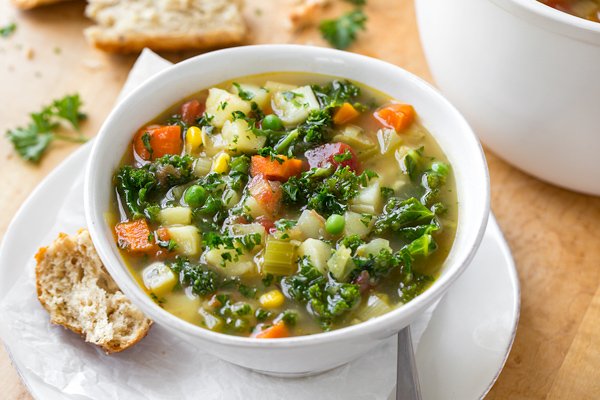
Sautéing vegetables with spices enhances the aromatic and savory profile of your soup:
- Heat olive oil or butter in a large pot over medium heat.
- Add onions, garlic, and celery; sauté until onions turn translucent.
- Add carrots and cook for 3–4 minutes to slightly soften them.
- Sprinkle in herbs and paprika to release their fragrance.
Pro Tip: Use a mix of fresh and dried herbs for richer flavor. Thyme, oregano, and bay leaves work particularly well for cold-weather soups.
Step 4: Add Broth and Cook Vegetables
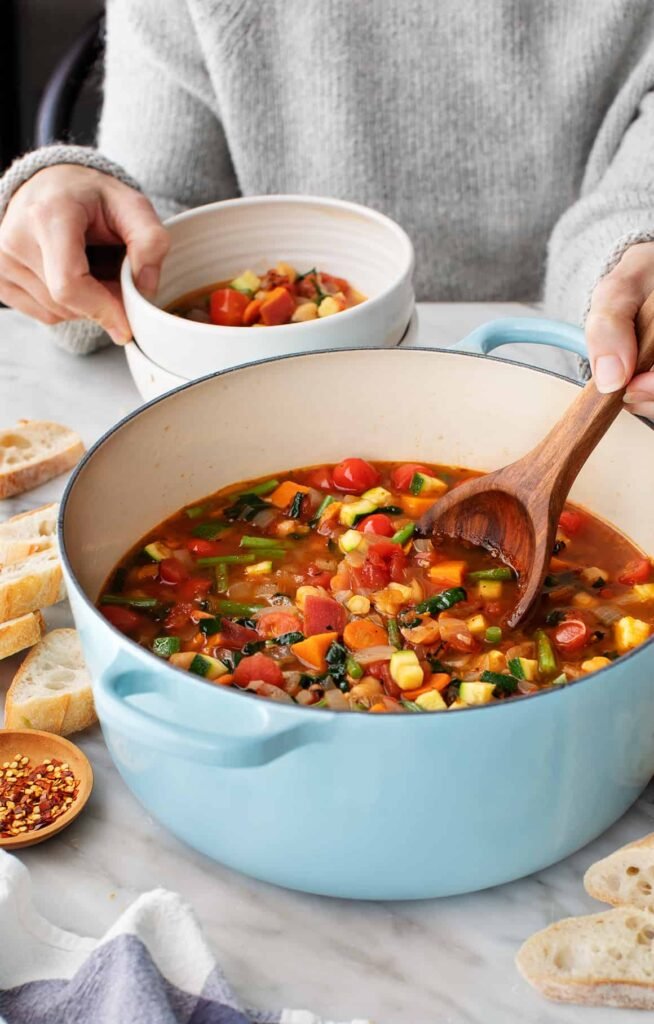
Adding liquid at the right stage ensures perfectly tender vegetables:
- Pour in vegetable broth or water and bring to a gentle boil.
- Add diced potatoes, green beans, broccoli, corn, and peas.
- Reduce heat and simmer for 15–20 minutes until all vegetables are tender.
- Taste and adjust salt, pepper, and seasoning as needed.
Pro Tip: For extra depth, simmer the soup for a few minutes longer to allow flavors to meld, especially when using fresh herbs.
Step 5: Optional Blending for Creamy Texture

Depending on your preference, you can enjoy the soup chunky or smooth:
- For a chunky soup, leave vegetables as they are and serve directly.
- For a creamy, smooth texture, use an immersion blender to blend the soup partially or fully.
- Optionally, add a splash of milk, cream, or coconut milk for a richer flavor without overpowering the vegetables.
Pro Tip: Blending just half of the soup creates a creamy yet chunky texture that’s perfect for family meals.
Step 6: Garnish and Serve
Finishing touches make the soup visually appealing and flavorful:
- Ladle soup into bowls and sprinkle with fresh parsley or cilantro.
- Drizzle with olive oil or add a squeeze of lemon juice for brightness.
- Serve with croutons, whole-grain bread, or crackers for a satisfying meal.
Pro Tip: Top with a few roasted nuts or seeds for extra crunch and nutrition.
Tips for Making the Best Vegetable Soup
- Season Gradually: Adjust seasoning throughout cooking to balance flavors.
- Use Fresh Herbs: Fresh parsley, cilantro, or basil adds brightness.
- Layer Flavors: Sauté aromatics first for deeper taste rather than adding everything at once.
- Customize Vegetables: Swap in seasonal favorites like squash, zucchini, or leafy greens.
- Meal Prep Friendly: Make a large batch and store in airtight containers for up to 4 days.
Health Benefits of Vegetable Soup
- High in Fiber: Vegetables provide dietary fiber, supporting digestion and fullness.
- Rich in Vitamins and Minerals: Carrots, broccoli, and tomatoes supply vitamin A, C, K, and antioxidants.
- Low-Calorie and Heart-Healthy: Light, nutritious, and low in saturated fat.
- Immune-Boosting: Garlic, onions, and herbs enhance immunity and overall health.
- Hydrating and Comforting: Warm liquid intake is soothing and hydrating during cold evenings.
Vegetable soup is a nutritious, light, and comforting meal that’s perfect for Americans seeking healthy, home-cooked options for cold evenings.
Why Americans Love Vegetable Soup
- Quick and Easy: Ready in under 40 minutes, ideal for busy weekdays.
- Customizable: Swap vegetables, herbs, and spices to suit taste and seasonal availability.
- Kid-Friendly: Mild, flavorful, and easy to digest, suitable for the whole family.
- Versatile: Serve as a starter, main dish, or alongside sandwiches and bread.
- Warm and Comforting: Perfect for cold evenings, providing both nourishment and coziness.
Vegetable soup brings wholesome nutrition and comforting warmth into American kitchens while remaining easy, healthy, and satisfying.
Final Thoughts
Making vegetable soup for cold evenings is simple, nutritious, and incredibly versatile. By following these **six steps—gathering ingredients, prepping vegetables, sautéing aromatics, adding broth, optional blending, and garnishing—you can create a warm, flavorful, and healthy soup perfect for family dinners or solo meals.
Serve it hot with bread, croutons, or a side salad, and enjoy a nutritious, comforting, and heartwarming meal that’s perfect for winter, chilly evenings, or whenever you crave a healthy, satisfying bowl of soup.
